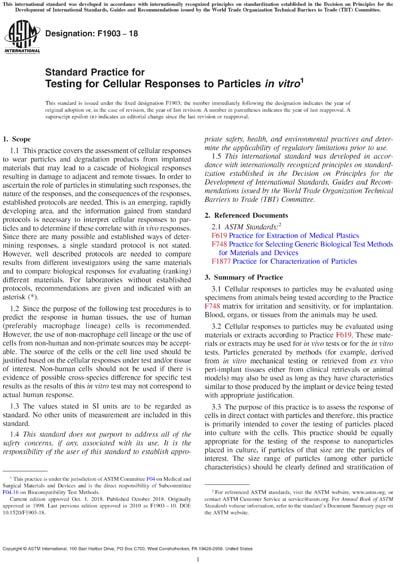Most recent
ASTM F1903-18
Standard Practice for Testing for Cellular Responses to Particles in vitro
1.1 This practice covers the assessment of cellular responses to wear particles and degradation products from implanted materials that may lead to a cascade of biological responses resulting in damage to adjacent and remote tissues. In order to ascertain the role of particles in stimulating such responses, the nature of the responses, and the consequences of the responses, established protocols are needed. This is an emerging, rapidly developing area, and the information gained from standard protocols is necessary to interpret cellular responses to particles and to determine if these correlate with in vivo responses. Since there are many possible and established ways of determining responses, a single standard protocol is not stated. However, well described protocols are needed to compare results from different investigators using the same materials and to compare biological responses for evaluating (ranking) different materials. For laboratories without established protocols, recommendations are given and indicated with an asterisk (*).
1.2 Since the purpose of the following test procedures is to predict the response in human tissues, the use of human (preferably macrophage lineage) cells is recommended. However, the use of non-macrophage cell lineage or the use of cells from non-human and non-primate sources may be acceptable. The source of the cells or the cell line used should be justified based on the cellular responses under test and/or tissue of interest. Non-human cells should not be used if there is evidence of possible cross-species difference for specific test results as the results of this in vitro test may not correspond to actual human response.
1.3 The values stated in SI units are to be regarded as standard. No other units of measurement are included in this standard.
1.4 This standard does not purport to address all of the safety concerns, if any, associated with its use. It is the responsibility of the user of this standard to establish appropriate safety, health, and environmental practices and determine the applicability of regulatory limitations prior to use.
1.5 This international standard was developed in accordance with internationally recognized principles on standardization established in the Decision on Principles for the Development of International Standards, Guides and Recommendations issued by the World Trade Organization Technical Barriers to Trade (TBT) Committee.
Content Provider
ASTM International [astm]






